SKODA OCTAVIA 2006 Owner´s Manual
Manufacturer: SKODA, Model Year: 2006, Model line: OCTAVIA, Model: SKODA OCTAVIA 2006Pages: 218, PDF Size: 5.48 MB
Page 61 of 218
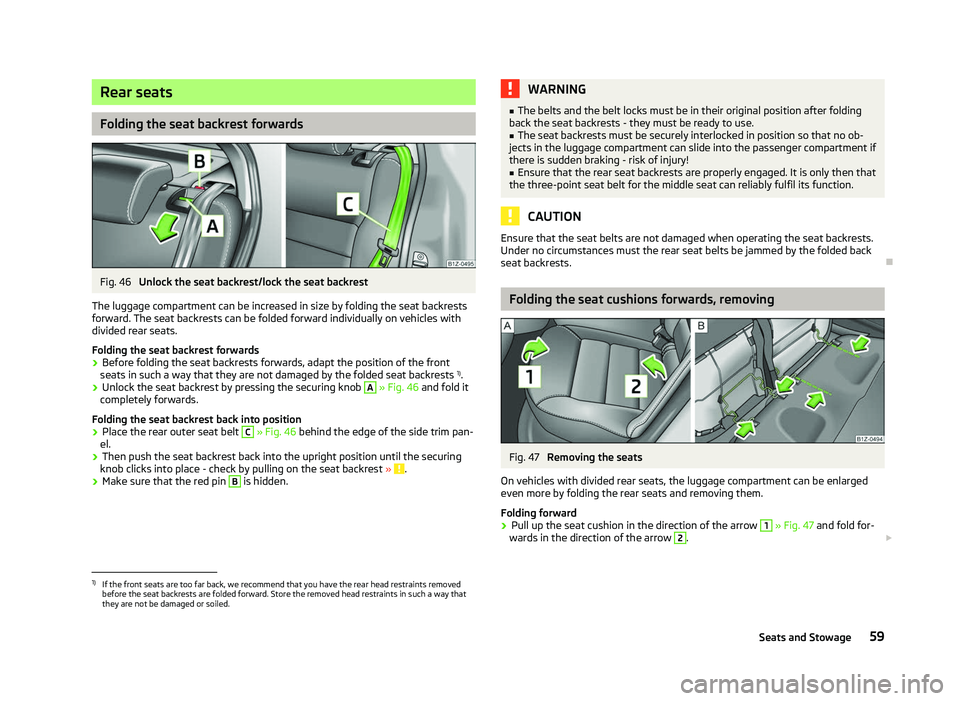
Rear seats
Folding the seat backrest forwards
Fig. 46
Unlock the seat backrest/lock the seat backrest
The luggage compartment can be increased in size by folding the seat backrests
forward. The seat backrests can be folded forward individually on vehicles with
divided rear seats.
Folding the seat backrest forwards
› Before folding the seat backrests forwards, adapt the position of the front
seats in such a way that they are not damaged by the folded seat backrests 1)
.
› Unlock the seat backrest by pressing the securing knob A
» Fig. 46
and fold it
completely forwards.
Folding the seat backrest back into position
› Place the rear outer seat belt C
» Fig. 46 behind the edge of the side trim pan-
el.
› Then push the seat backrest back into the upright position until the securing
knob clicks into place - check by pulling on the seat backrest » .
› Make sure that the red pin B
is hidden. WARNING
■ The belts and the belt locks must be in their original position after folding
back the seat backrests - they must be ready to use.
■ The seat backrests must be securely interlocked in position so that no ob-
jects in the luggage compartment can slide into the passenger compartment if
there is sudden braking - risk of injury! ■ Ensure that the rear seat backrests are properly engaged. It is only then that
the three-point seat belt for the middle seat can reliably fulfil its function. CAUTION
Ensure that the seat belts are not damaged when operating the seat backrests.
Under no circumstances must the rear seat belts be jammed by the folded back
seat backrests. Ð Folding the seat cushions forwards, removing
Fig. 47
Removing the seats
On vehicles with divided rear seats, the luggage compartment can be enlarged
even more by folding the rear seats and removing them.
Folding forward
› Pull up the seat cushion in the direction of the arrow 1
» Fig. 47 and fold for-
wards in the direction of the arrow 2
.
£1)
If the front seats are too far back, we recommend that you have the rear head restraints removed
before the seat backrests are folded forward. Store the removed head restraints in such a way that
they are not be damaged or soiled.
59
Seats and Stowage
Page 62 of 218
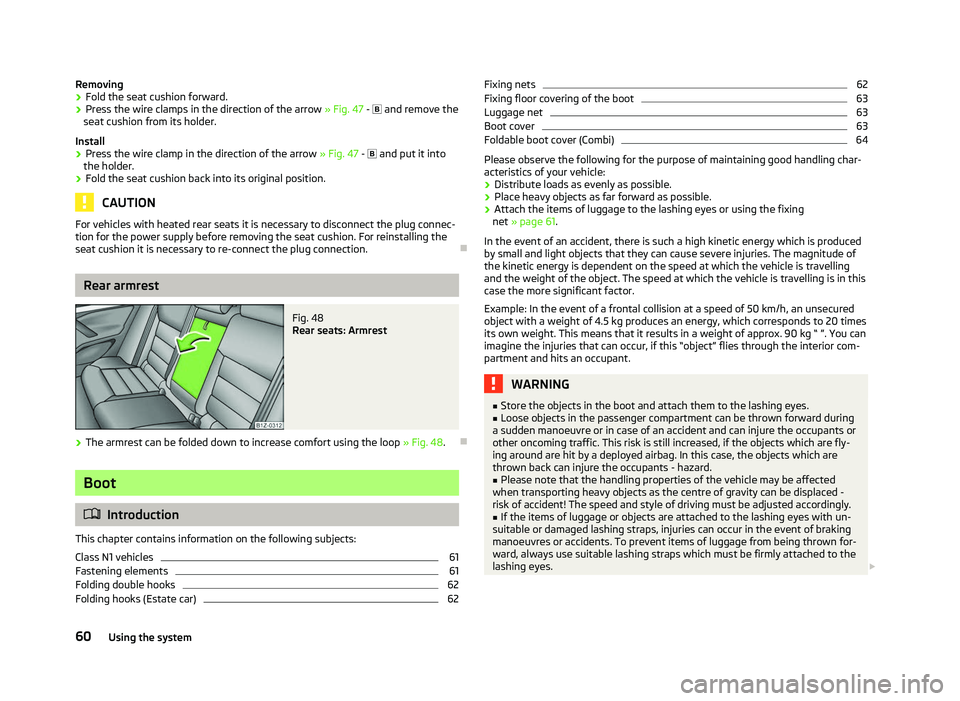
Removing
›
Fold the seat cushion forward.
› Press the wire clamps in the direction of the arrow
» Fig. 47 - and remove the
seat cushion from its holder.
Install
› Press the wire clamp in the direction of the arrow
» Fig. 47 - and put it into
the holder.
› Fold the seat cushion back into its original position. CAUTION
For vehicles with heated rear seats it is necessary to disconnect the plug connec-
tion for the power supply before removing the seat cushion. For reinstalling the
seat cushion it is necessary to re-connect the plug connection. ÐRear armrest
Fig. 48
Rear seats: Armrest
› The armrest can be folded down to increase comfort using the loop
» Fig. 48.Ð Boot
ä
Introduction
This chapter contains information on the following subjects:
Class
N1 vehicles 61
Fastening elements 61
Folding double hooks 62
Folding hooks (Estate car) 62Fixing nets 62
Fixing floor covering of the boot 63
Luggage net 63
Boot cover 63
Foldable boot cover (Combi) 64
Please observe the following for the purpose of maintaining good handling char-
acteristics of your vehicle:
› Distribute loads as evenly as possible.
› Place heavy objects as far forward as possible.
› Attach the items of luggage to the lashing eyes or using the fixing
net »
page 61 .
In the event of an accident, there is such a high kinetic energy which is produced
by small and light objects that they can cause severe injuries. The magnitude of
the kinetic energy is dependent on the speed at which the vehicle is travelling
and the weight of the object. The speed at which the vehicle is travelling is in this
case the more significant factor.
Example: In the event of a frontal collision at a speed of 50 km/h, an unsecured
object with a weight of 4.5 kg produces an energy, which corresponds to 20 times
its own weight. This means that it results in a weight of approx. 90 kg “ ”. You can
imagine the injuries that can occur, if this “object” flies through the interior com-
partment and hits an occupant. WARNING
■ Store the objects in the boot and attach them to the lashing eyes.
■ Loose objects in the passenger compartment can be thrown forward during
a sudden manoeuvre or in case of an accident and can injure the occupants or
other oncoming traffic. This risk is still increased, if the objects which are fly-
ing around are hit by a deployed airbag. In this case, the objects which are
thrown back can injure the occupants - hazard. ■ Please note that the handling properties of the vehicle may be affected
when transporting heavy objects as the centre of gravity can be displaced -
risk of accident! The speed and style of driving must be adjusted accordingly. ■ If the items of luggage or objects are attached to the lashing eyes with un-
suitable or damaged lashing straps, injuries can occur in the event of braking
manoeuvres or accidents. To prevent items of luggage from being thrown for-
ward, always use suitable lashing straps which must be firmly attached to the
lashing eyes. £
60 Using the system
Page 63 of 218

WARNING (Continued)
■ The items carried in the boot must be stored in such a way that no objects
are able to slip forward if any sudden driving or braking manoeuvres are un-
dertaken - risk of injury! ■ When transporting fastened objects which are sharp and dangerous in the
boot that has been enlarged by folding the rear seats forward, ensure the
safety of the passengers transported on the other rear seats » page 123, Cor-
rect seated position for the occupants on the rear seats .
■ If the rear seat next to the folded forward seat is occupied, ensure maxi-
mum safety, e.g. by placing the goods to be transported in such a way that the
seat is prevented from folding back in case of a rear collision.
■ Never drive with the boot lid fully opened or slightly ajar otherwise exhaust
gases may get into the interior of the vehicle - risk of poisoning!
■ Under no circumstances, should the permissible axle loads and permissible
gross weight of the vehicle be exceeded - risk of accident!
■ Never transport people in the boot! CAUTION
Make sure that transported objects with sharp edges do not damage the follow-
ing:
■ heating elements in the rear window;
■ elements of the aerial integrated in the rear window;
■ elements of the aerial integrated in the rear side windows (Estate car). Note
Tyre pressure must be adjusted to the load » page 171, Service life of tyres.ÐClass N1 vehicles
First read and observe the introductory information and safety warn-
ings on page 60.
On class N1 vehicles, which are not fitted with a protective grille, a lashing set
which complies with the standard EN
12195 (1 - 4) must be used for fastening the
load. Ð
ä Fastening elements
Fig. 49
Boot: Lashing eyes and fastening elements/Combi lashing eyes and
fastening elements
First read and observe the introductory information and safety warn-
ings on page 60.
The boot provides the following fastening elements
»
Fig. 49.
Lashing eyes for fastening items of luggage and fixing nets.
Fastening elements for fastening fixing nets. CAUTION
The maximum permissible load of the lashing eyes is 3.5 kN (350 kg). Note
The upper front lashing eyes are located underneath the folding rear seat back-
rest » Fig. 49. Ð
ä A
B
61
Seats and Stowage
Page 64 of 218
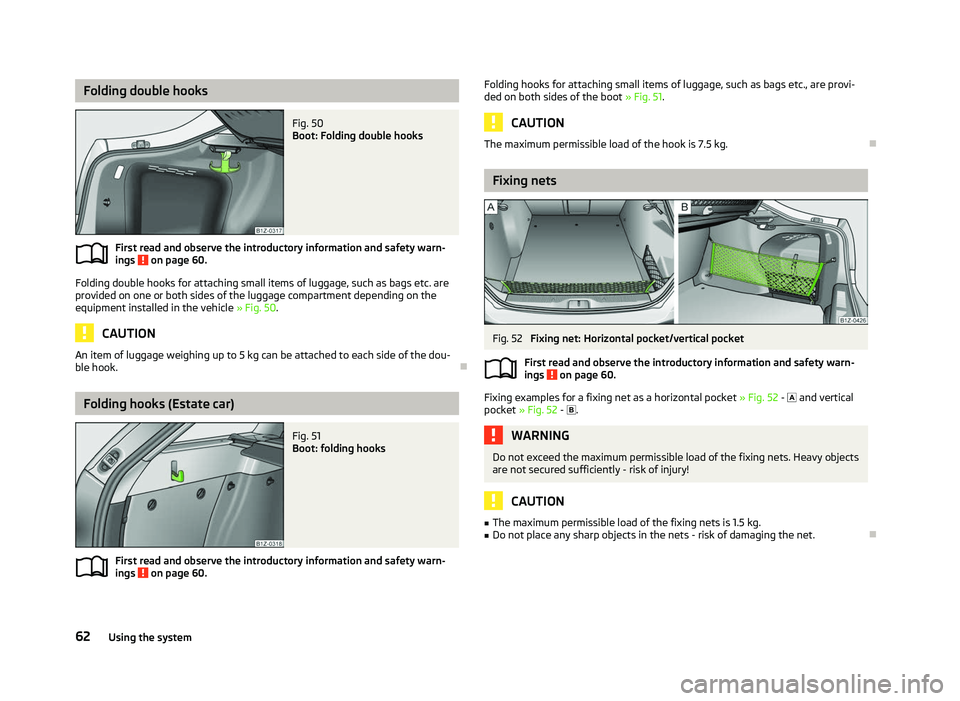
Folding double hooks
Fig. 50
Boot: Folding double hooks
First read and observe the introductory information and safety warn-
ings on page 60.
Folding double hooks for attaching small items of luggage, such as bags etc. are
provided on one or both sides of the luggage compartment depending on the
equipment installed in the vehicle » Fig. 50.CAUTION
An item of luggage weighing up to 5 kg can be attached to each side of the dou-
ble hook. ÐFolding hooks (Estate car)
Fig. 51
Boot: folding hooks
First read and observe the introductory information and safety warn-
ings on page 60.ä
ä Folding hooks for attaching small items of luggage, such as bags etc., are provi-
ded on both sides of the boot » Fig. 51. CAUTION
The maximum permissible load of the hook is 7.5 kg. Ð Fixing nets
Fig. 52
Fixing net: Horizontal pocket/vertical pocket
First read and observe the introductory information and safety warn-
ings on page 60.
Fixing examples for a fixing net as a horizontal pocket
» Fig. 52 - and vertical
pocket » Fig. 52 - . WARNING
Do not exceed the maximum permissible load of the fixing nets. Heavy objects
are not secured sufficiently - risk of injury! CAUTION
■ The maximum permissible load of the fixing nets is 1.5
kg.
■ Do not place any sharp objects in the nets - risk of damaging the net. Ð
ä
62 Using the system
Page 65 of 218
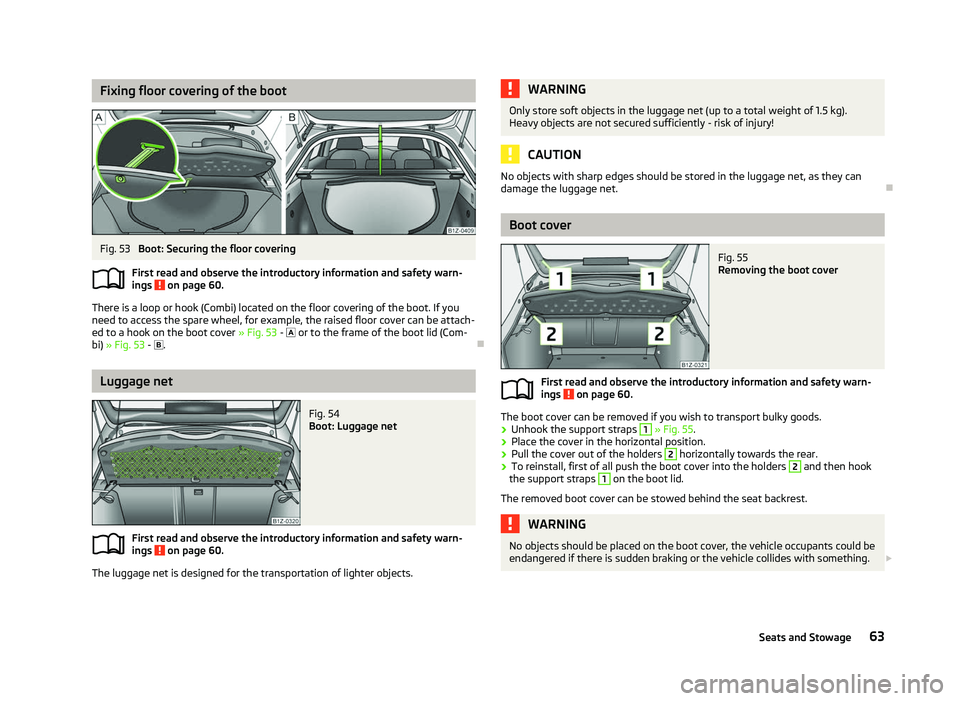
Fixing floor covering of the boot
Fig. 53
Boot: Securing the floor covering
First read and observe the introductory information and safety warn-
ings on page 60.
There is a loop or hook (Combi) located on the floor covering of the boot. If you
need to access the spare wheel, for example, the raised floor cover can be attach-
ed to a hook on the boot cover » Fig. 53 -
or to the frame of the boot lid (Com-
bi) » Fig. 53 - . ÐLuggage net
Fig. 54
Boot: Luggage net
First read and observe the introductory information and safety warn-
ings on page 60.
The luggage net is designed for the transportation of lighter objects.ä
ä WARNING
Only store soft objects in the luggage net (up to a total weight of 1.5 kg).
Heavy objects are not secured sufficiently - risk of injury! CAUTION
No objects with sharp edges should be stored in the luggage net, as they can
damage the luggage net. Ð Boot cover
Fig. 55
Removing the boot cover
First read and observe the introductory information and safety warn-
ings on page 60.
The boot cover can be removed if you wish to transport bulky goods.
›
Unhook the support straps 1
» Fig. 55.
› Place the cover in the horizontal position.
› Pull the cover out of the holders 2
horizontally towards the rear.
› To reinstall, first of all push the boot cover into the holders 2
and then hook
the support straps 1
on the boot lid.
The removed boot cover can be stowed behind the seat backrest. WARNING
No objects should be placed on the boot cover, the vehicle occupants could be
endangered if there is sudden braking or the vehicle collides with something. £
ä
63
Seats and Stowage
Page 66 of 218
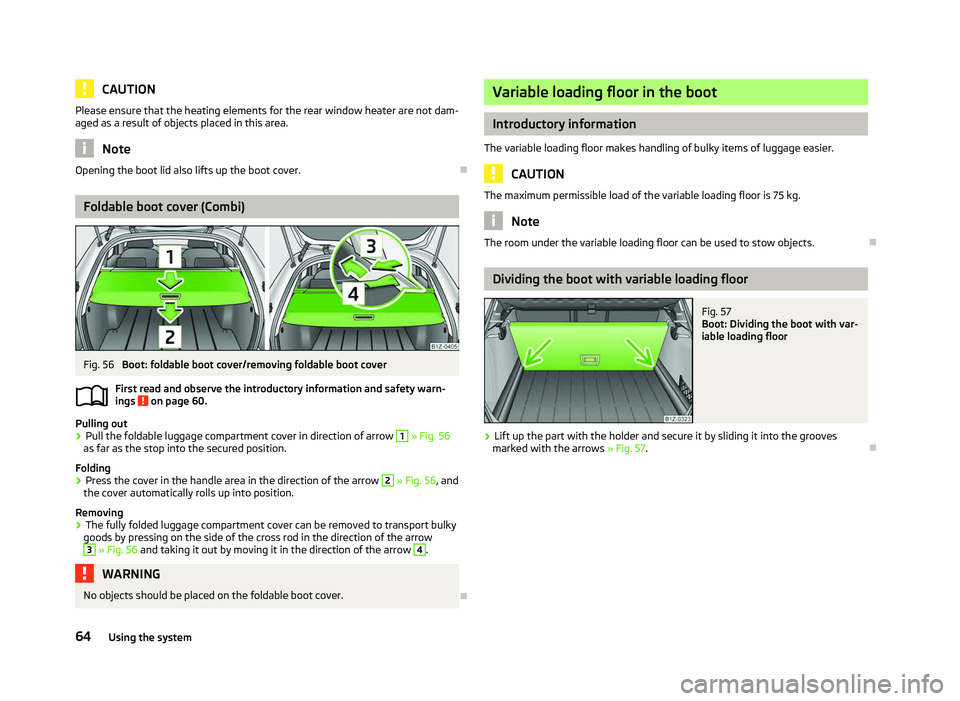
CAUTION
Please ensure that the heating elements for the rear window heater are not dam-
aged as a result of objects placed in this area. Note
Opening the boot lid also lifts up the boot cover. ÐFoldable boot cover (Combi)
Fig. 56
Boot: foldable boot cover/removing foldable boot cover
First read and observe the introductory information and safety warn-
ings on page 60.
Pulling out
›
Pull the foldable luggage compartment cover in direction of arrow 1
» Fig. 56
as far as the stop into the secured position.
Folding
› Press the cover in the handle area in the direction of the arrow 2
» Fig. 56
, and
the cover automatically rolls up into position.
Removing
› The fully folded luggage compartment cover can be removed to transport bulky
goods by pressing on the side of the cross rod in the direction of the arrow 3
» Fig. 56
and taking it out by moving it in the direction of the arrow 4
.
WARNING
No objects should be placed on the foldable boot cover. Ð
ä Variable loading floor in the boot
Introductory information
The variable loading floor makes handling of bulky items of luggage easier. CAUTION
The maximum permissible load of the variable loading floor is 75 kg. Note
The room under the variable loading floor can be used to stow objects. Ð Dividing the boot with variable loading floor
Fig. 57
Boot: Dividing the boot with var-
iable loading floor
› Lift up the part with the holder and secure it by sliding it into the grooves
marked with the arrows »
Fig. 57. Ð
64 Using the system
Page 67 of 218
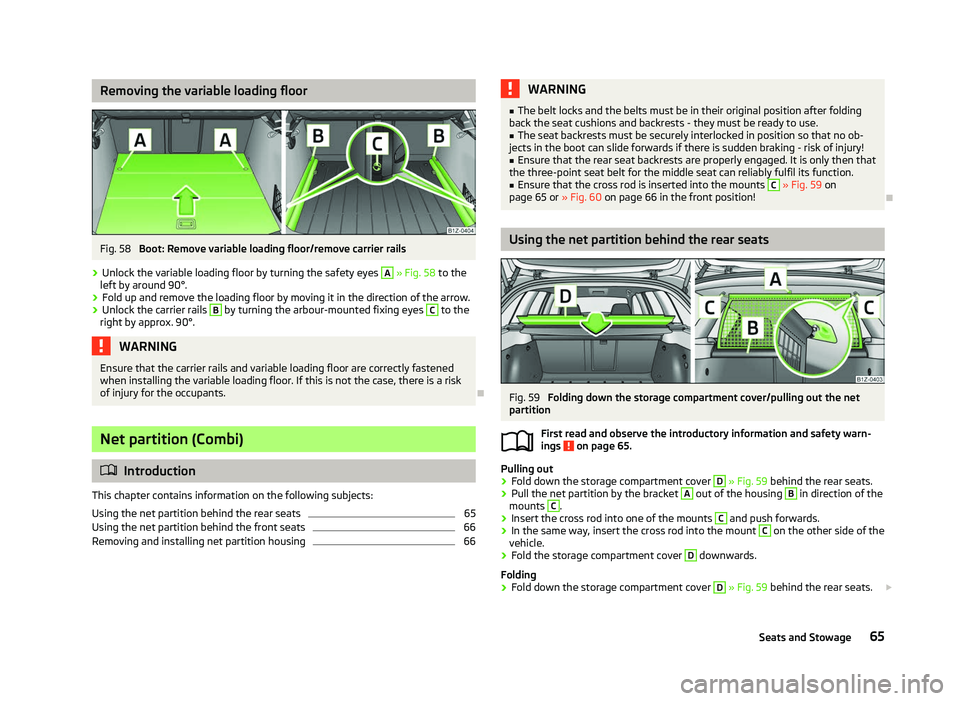
Removing the variable loading floor
Fig. 58
Boot: Remove variable loading floor/remove carrier rails
› Unlock the variable loading floor by turning the safety eyes A
» Fig. 58
to the
left by around 90°.
› Fold up and remove the loading floor by moving it in the direction of the arrow.
› Unlock the carrier rails B
by turning the arbour-mounted fixing eyes C
to the
right by approx. 90°. WARNING
Ensure that the carrier rails and variable loading floor are correctly fastened
when installing the variable loading floor. If this is not the case, there is a risk
of injury for the occupants. ÐNet partition (Combi)
ä
Introduction
This chapter contains information on the following subjects:
Using the net partition behind the rear seats 65
Using the net partition behind the front seats 66
Removing and installing net partition housing 66 WARNING
■ The belt locks and the belts must be in their original position after folding
back the seat cushions and backrests - they must be ready to use.
■ The seat backrests must be securely interlocked in position so that no ob-
jects in the boot can slide forwards if there is sudden braking - risk of injury!
■ Ensure that the rear seat backrests are properly engaged. It is only then that
the three-point seat belt for the middle seat can reliably fulfil its function. ■ Ensure that the cross rod is inserted into the mounts C
» Fig. 59 on
page 65 or » Fig. 60 on page 66 in the front position! Ð Using the net partition behind the rear seats
Fig. 59
Folding down the storage compartment cover/pulling out the net
partition
First read and observe the introductory information and safety warn-
ings on page 65.
Pulling out
› Fold down the storage compartment cover D
» Fig. 59 behind the rear seats.
› Pull the net partition by the bracket A
out of the housing B
in direction of the
mounts C
.
› Insert the cross rod into one of the mounts C
and push forwards.
› In the same way, insert the cross rod into the mount C
on the other side of the
vehicle.
› Fold the storage compartment cover D
downwards.
Folding
› Fold down the storage compartment cover D
» Fig. 59 behind the rear seats.
£
ä
65
Seats and Stowage
Page 68 of 218
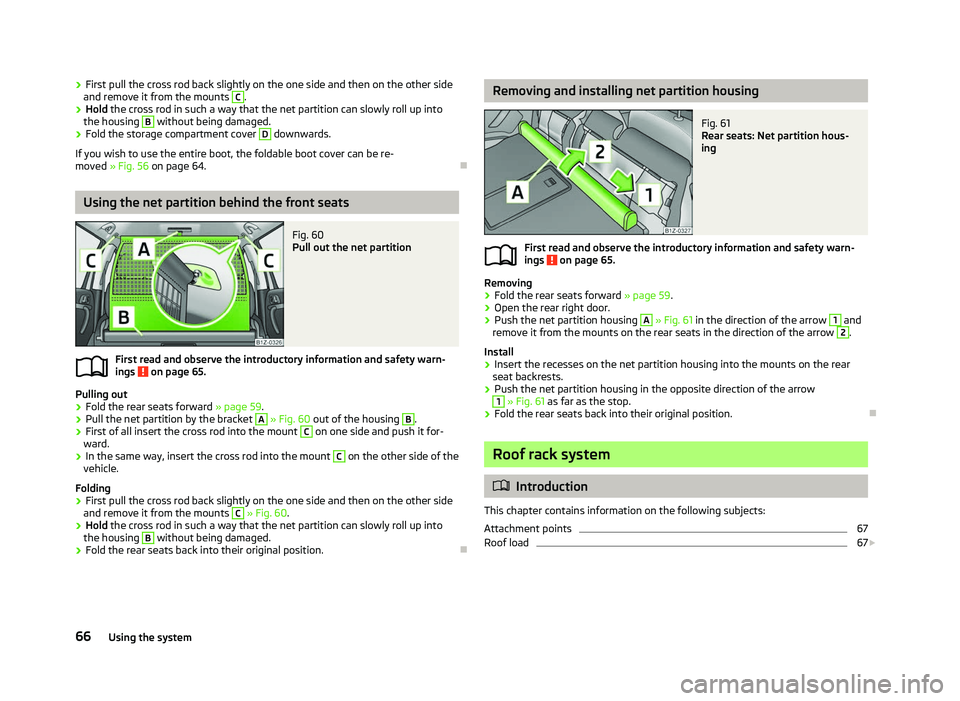
›
First pull the cross rod back slightly on the one side and then on the other side
and remove it from the mounts C
.
› Hold the cross rod in such a way that the net partition can slowly roll up into
the housing B
without being damaged.
› Fold the storage compartment cover D
downwards.
If you wish to use the entire boot, the foldable boot cover can be re-
moved » Fig. 56 on page 64. ÐUsing the net partition behind the front seats
Fig. 60
Pull out the net partition
First read and observe the introductory information and safety warn-
ings on page 65.
Pulling out
› Fold the rear seats forward
» page 59.
› Pull the net partition by the bracket A
» Fig. 60
out of the housing B
.
› First of all insert the cross rod into the mount C
on one side and push it for-
ward.
› In the same way, insert the cross rod into the mount C
on the other side of the
vehicle.
Folding
› First pull the cross rod back slightly on the one side and then on the other side
and remove it from the mounts C
» Fig. 60
.
› Hold the cross rod in such a way that the net partition can slowly roll up into
the housing B
without being damaged.
› Fold the rear seats back into their original position. Ð
ä Removing and installing net partition housing
Fig. 61
Rear seats: Net partition hous-
ing
First read and observe the introductory information and safety warn-
ings on page 65.
Removing
› Fold the rear seats forward
»
page 59.
› Open the rear right door.
› Push the net partition housing A
» Fig. 61 in the direction of the arrow 1
and
remove it from the mounts on the rear seats in the direction of the arrow 2
.
Install
› Insert the recesses on the net partition housing into the mounts on the rear
seat backrests.
› Push the net partition housing in the opposite direction of the arrow 1
» Fig. 61 as far as the stop.
› Fold the rear seats back into their original position. Ð Roof rack system
ä
Introduction
This chapter contains information on the following subjects:
Attachment points 67
Roof load 67
£
ä
66 Using the system
Page 69 of 218
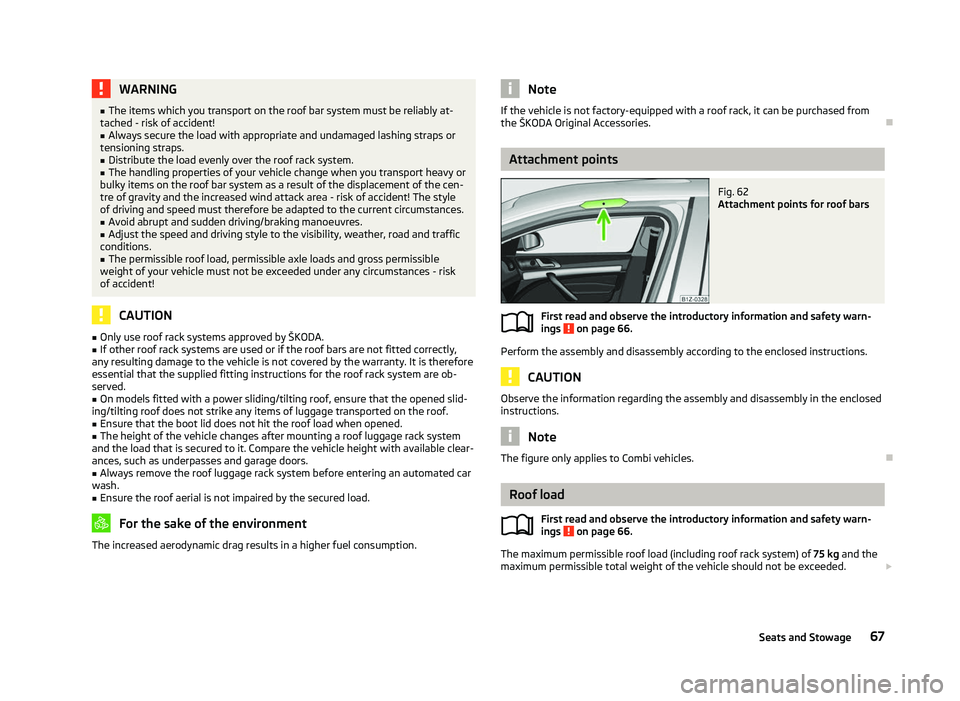
WARNING
■ The items which you transport on the roof bar system must be reliably at-
tached - risk of accident!
■ Always secure the load with appropriate and undamaged lashing straps or
tensioning straps. ■ Distribute the load evenly over the roof rack system.
■ The handling properties of your vehicle change when you transport heavy or
bulky items on the roof bar system as a result of the displacement of the cen-
tre of gravity and the increased wind attack area - risk of accident! The style
of driving and speed must therefore be adapted to the current circumstances. ■ Avoid abrupt and sudden driving/braking manoeuvres.
■ Adjust the speed and driving style to the visibility, weather, road and traffic
conditions. ■ The permissible roof load, permissible axle loads and gross permissible
weight of your vehicle must not be exceeded under any circumstances - risk
of accident! CAUTION
■ Only use roof rack systems approved by ŠKODA.
■ If other roof rack systems are used or if the roof bars are not fitted correctly,
any resulting damage to the vehicle is not covered by the warranty. It is therefore
essential that the supplied fitting instructions for the roof rack system are ob-
served.
■ On models fitted with a power sliding/tilting roof, ensure that the opened slid-
ing/tilting roof does not strike any items of luggage transported on the roof. ■ Ensure that the boot lid does not hit the roof load when opened.
■ The height of the vehicle changes after mounting a roof luggage rack system
and the load that is secured to it. Compare the vehicle height with available clear-
ances, such as underpasses and garage doors.
■ Always remove the roof luggage rack system before entering an automated car
wash. ■ Ensure the roof aerial is not impaired by the secured load. For the sake of the environment
The increased aerodynamic drag results in a higher fuel consumption. Note
If the vehicle is not factory-equipped with a roof rack, it can be purchased from
the
ŠKODA Original Accessories. Ð Attachment points
Fig. 62
Attachment points for roof bars
First read and observe the introductory information and safety warn-
ings on page 66.
Perform the assembly and disassembly according to the enclosed instructions.
CAUTION
Observe the information regarding the assembly and disassembly in the enclosed
instructions. Note
The figure only applies to Combi vehicles. Ð Roof load
First read and observe the introductory information and safety warn-
ings on page 66.
The maximum permissible roof load (including roof rack system) of
75 kg and the
maximum permissible total weight of the vehicle should not be exceeded. £
ä
ä
67
Seats and Stowage
Page 70 of 218
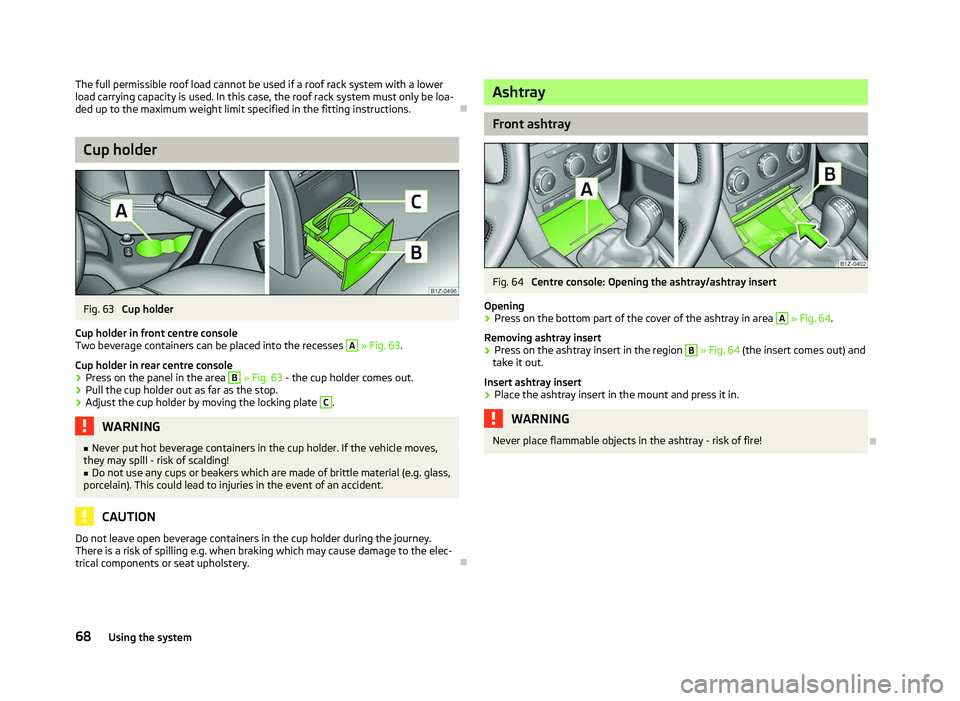
The full permissible roof load cannot be used if a roof rack system with a lower
load carrying capacity is used. In this case, the roof rack system must only be loa-
ded up to the maximum weight limit specified in the fitting instructions.
ÐCup holder
Fig. 63
Cup holder
Cup holder in front centre console
Two beverage containers can be placed into the recesses A
» Fig. 63.
Cup holder in rear centre console
› Press on the panel in the area B
» Fig. 63 - the cup holder comes out.
› Pull the cup holder out as far as the stop.
› Adjust the cup holder by moving the locking plate C
.
WARNING
■ Never put hot beverage containers in the cup holder. If the vehicle moves,
they may spill - risk of scalding!
■ Do not use any cups or beakers which are made of brittle material (e.g. glass,
porcelain). This could lead to injuries in the event of an accident. CAUTION
Do not leave open beverage containers in the cup holder during the journey.
There is a risk of spilling e.g. when braking which may cause damage to the elec-
trical components or seat upholstery. Ð Ashtray
Front ashtray
Fig. 64
Centre console: Opening the ashtray/ashtray insert
Opening
› Press on the bottom part of the cover of the ashtray in area A
» Fig. 64
.
Removing ashtray insert
› Press on the ashtray insert in the region B
» Fig. 64
(the insert comes out) and
take it out.
Insert ashtray insert
› Place the ashtray insert in the mount and press it in. WARNING
Never place flammable objects in the ashtray - risk of fire! Ð
68 Using the system